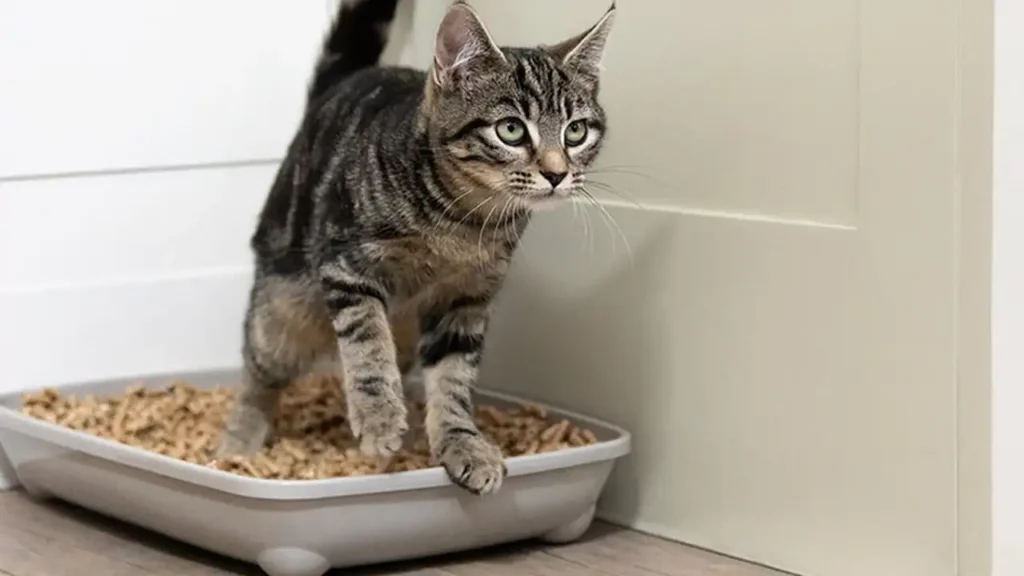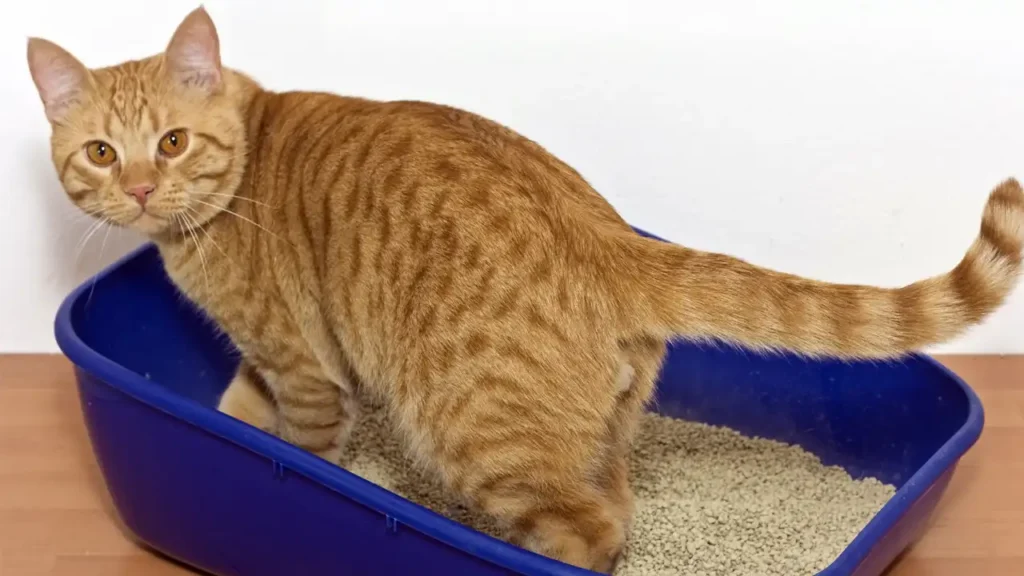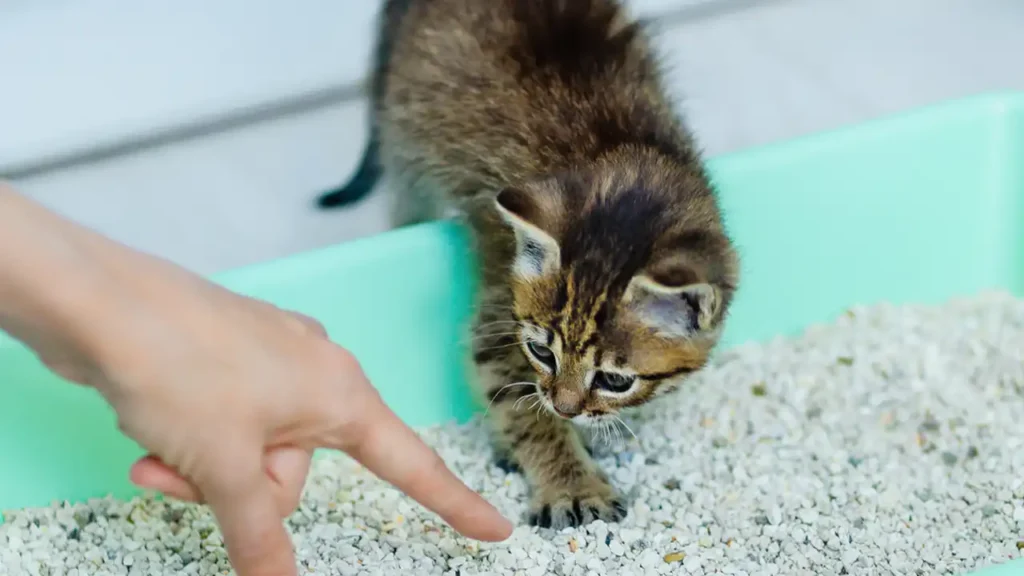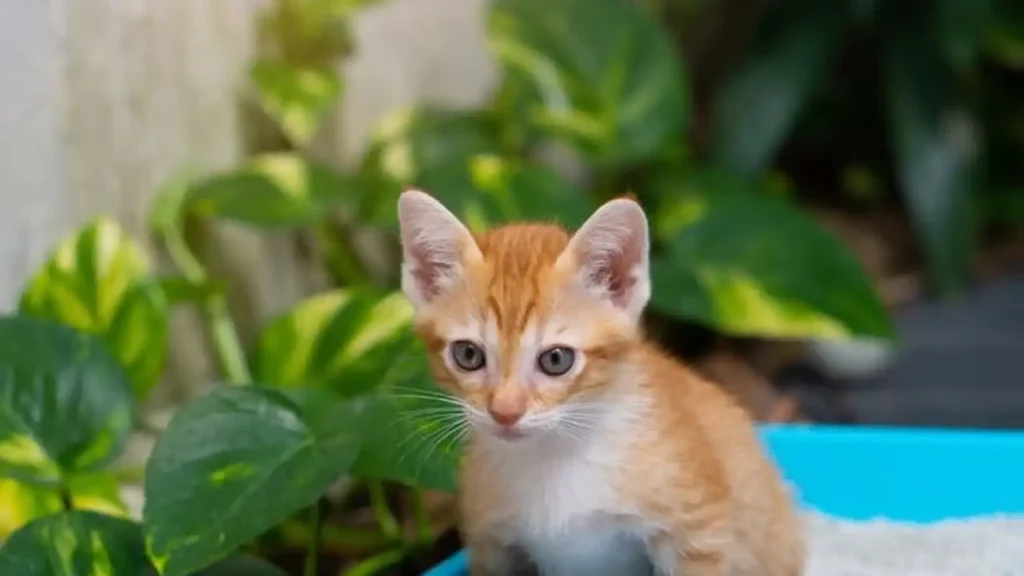Litter training is an essential step in caring for your cat. A well-trained cat will use the litter box consistently, reducing mess and promoting a harmonious living environment. This guide will provide you with effective tips and techniques to help you successfully litter train your feline friend, whether it’s a kitten or an adult cat.
By following these steps and maintaining a positive approach, you can ensure a smooth training process and a happy, litter-trained cat.
Are Cats Automatically Litter Trained?
No, cats are not automatically naturally litter trained. While some kittens may instinctively understand how to use a litter box, others will need to be taught. It’s essential to start litter training your kitten or adult cat early to ensure a smooth and successful process.
By following the tips and techniques outlined in our guide, you can effectively train your feline friend to use the litter box consistently and maintain a clean and hygienic environment.
How to Litter Train a Cat?

Litter training is a crucial step in caring for your cat. It helps to maintain a clean and hygienic environment and prevents unwanted behaviors like inappropriate elimination. Here’s a step-by-step guide to help you successfully litter train your feline friend:
1. Start Early
- Kittens: Begin litter training as soon as you bring your kitten home. Kittens are naturally curious and will often learn to use the litter box quickly.
- Adult Cats: If you’re adopting an adult cat, introduce it to the litter box immediately. While it may take longer for an adult cat to learn, it’s still possible with patience and consistency.
2. Provide Adequate Litter Boxes
- Number of Boxes: As a general rule, provide one litter box per cat plus one additional box. This ensures that there are enough litter boxes for your cats to use without feeling territorial.
- Placement: Place litter boxes in quiet, easily accessible areas away from food and water sources. Avoid placing them near loud noises or areas that may scare your cat.
3. Use the Right Litter
- Clumping or Non-Clumping: Experiment with different types of litter to find what your cat prefers. Some cats may be sensitive to certain types of litter or odors.
- Consistency: Once you’ve found a litter that works, stick with it to avoid confusing your cat.
4. Show Your Cat the Litter Box
- Gentle Introduction: Gently place your cat in the litter box and let it explore. Some cats may instinctively understand what to do, while others may need a little encouragement.
- Positive Reinforcement: Reward your cat with treats or praise when it uses the litter box. This will help associate the litter box with positive experiences.
5. Be Patient and Consistent
- Avoid Punishment: Never punish your cat for accidents. This can lead to stress and anxiety, making it more difficult to train your cat.
- Clean Up Accidents: If your cat has an accident outside the litter box, clean it up thoroughly with an enzymatic cleaner to remove any odor.
- Monitor Your Cat: Keep an eye on your cat’s behavior and watch for signs that it may need additional training.
Remember, every cat is different, and it may take some time for your cat to fully understand the concept of using a litter box. Be patient, consistent, and provide a positive learning environment. With patience and persistence, you can successfully litter train your feline friend.
How to Get Cat to Use Litter Box
Choosing the Right Litter Box:
- Size: Ensure the litter box is large enough for your cat to stretch out comfortably.
- Location: Place the litter box in a quiet, private area away from food and water sources.
- Number: For multi-cat households, provide at least one litter box per cat plus an extra.
Introducing the Litter Box:
- Positive Reinforcement: Reward your cat with treats or praise when they use the litter box.
- Scent: If your cat is hesitant, try adding a familiar scent, like your own, to the litter box.
- Gradual Introduction: Place your cat near the litter box and observe their behavior. If they show interest, gently guide them inside.
Litter Type:
- Experiment: Different cats prefer different litter types. Try various options like clay, silica gel, or natural litters.
- Avoid: Avoid scented litters, as strong odors can deter cats.
Cleaning and Maintenance:
- Regular Cleaning: Scoop out solid waste daily and completely clean the litter box at least once a week.
- Deep Cleaning: Deep clean the litter box with a mild detergent and hot water to remove any odors or bacteria.
Troubleshooting:
- Medical Issues: If your cat suddenly stops using the litter box, rule out any medical issues by consulting a veterinarian.
- Stress or Anxiety: Environmental changes, new pets, or other stressors can cause cats to become anxious and avoid the litter box. Provide a calm environment and consult a veterinarian if necessary.
Additional Tips:
- Patience: Training a cat can take time. Be patient and consistent with your efforts.
- Observe Behavior: Pay attention to your cat’s signals, as they may indicate discomfort or stress.
- Consult a Veterinarian: If you’re having trouble training your cat, consult a veterinarian for advice or to rule out any underlying health issues.
By following these tips, you can successfully train your cat to use the litter box and maintain a harmonious living environment.
Why Does My Litter Trained Cat Pee on Floor?
If your once litter-trained cat is suddenly urinating outside the litter box, it could be due to several factors. Here are some common reasons:
1. Medical Issues:
- Urinary Tract Infections (UTIs): UTIs can cause pain and discomfort, leading to your cat avoiding the litter box.
- Kidney Disease: Kidney problems can affect a cat’s ability to control their bladder.
- Feline Lower Urinary Tract Syndrome (FLUTD): This condition can cause pain and inflammation in the urinary tract, leading to inappropriate urination.
2. Environmental Factors:
- Dirty Litter Box: A dirty or unpleasant litter box may discourage your cat from using it.
- Litter Box Placement: If the litter box is in a noisy, crowded, or stressful location, your cat may avoid it.
- New Pets or People: Introducing new pets or people into your home can cause stress and anxiety for your cat, leading to behavioral changes.
3. Behavioral Issues:
- Stress or Anxiety: Cats can become stressed due to various reasons, such as changes in their environment, new pets, or loud noises. This can lead to inappropriate urination.
- Marking Territory: Male cats may mark their territory by spraying urine on vertical surfaces.
- Fear or Avoidance: If your cat is afraid of something in the litter box, such as a loud noise or a new litter type, it may avoid using it.
If your cat is consistently urinating outside the litter box, it’s important to consult with a veterinarian to rule out any underlying medical conditions. Once any medical issues have been addressed, you can investigate environmental and behavioral factors to determine the root cause of the problem.
By identifying and addressing the underlying issue, you can help your cat return to using the litter box consistently.
How to Train Cats to Pee in Litter Box?

Litter training is a crucial aspect of cat ownership. It ensures a clean and hygienic environment for both you and your feline friend. Here are some effective tips to train your cat to pee in the litter box:
1. Start Early
- Kittens: Begin litter training as soon as you bring your kitten home. Kittens are naturally curious and will often learn to use the litter box quickly.
- Adult Cats: If you’re adopting an adult cat, introduce it to the litter box immediately. While it may take longer for an adult cat to learn, it’s still possible with patience and consistency.
2. Provide Adequate Litter Boxes
- Number of Boxes: As a general rule, provide one litter box per cat plus one additional box. This ensures that there are enough litter boxes for your cats to use without feeling territorial.
- Placement: Place litter boxes in quiet, easily accessible areas away from food and water sources. Avoid placing them near loud noises or areas that may scare your cat.
3. Use the Right Litter
- Clumping or Non-Clumping: Experiment with different types of litter to find what your cat prefers. Some cats may be sensitive to certain types of litter or odors.
- Consistency: Once you’ve found a litter that works, stick with it to avoid confusing your cat.
4. Show Your Cat the Litter Box
- Gentle Introduction: Gently place your cat in the litter box and let it explore. Some cats may instinctively understand what to do, while others may need a little encouragement.
- Positive Reinforcement: Reward your cat with treats or praise when it uses the litter box. This will help associate the litter box with positive experiences.
5. Be Patient and Consistent
- Avoid Punishment: Never punish your cat for accidents. This can lead to stress and anxiety, making it more difficult to train your cat.
- Clean Up Accidents: If your cat has an accident outside the litter box, clean it up thoroughly with an enzymatic cleaner to remove any odor.
- Monitor Your Cat: Keep an eye on your cat’s behavior and watch for signs that it may need additional training.
Remember, every cat is different, and it may take some time for your cat to fully understand the concept of using a litter box. Be patient, consistent, and provide a positive learning environment. With patience and persistence, you can successfully litter train your feline friend.
When Is It Too Late to Litter Train a Cat?

It’s generally not too late to litter train a cat, no matter its age. While kittens are easier to train, adult cats can also learn to use the litter box with patience and consistency.
Here are some tips for training an adult cat:
- Start with a Clean Slate: If the cat is new to your home, start with a clean slate. Provide a new litter box, fresh litter, and a quiet, easily accessible location.
- Be Patient and Consistent: Adult cats may take longer to learn than kittens. Be patient and consistent with your training efforts.
- Offer Positive Reinforcement: Reward your cat with treats or praise when it uses the litter box successfully.
- Address Underlying Issues: If your adult cat is having trouble using the litter box, there may be an underlying health or behavioral issue. Consult with a veterinarian or feline behaviorist for advice.
Remember, every cat is different, and it may take some time for your adult cat to learn to use the litter box. With patience, consistency, and positive reinforcement, you can successfully train your feline friend.
What Age Are Cats Litter Trained?
The age at which cats are litter trained can vary. Some kittens may instinctively understand how to use a litter box as early as 3-4 weeks old, while others may take longer.
Here are some general guidelines:
- Kittens: Most kittens are litter trained by 6-8 weeks old.
- Adult Cats: Adult cats can be litter trained, but it may take longer and require more patience and consistency.
If you’re having trouble litter training your cat, it’s important to consult with a veterinarian or feline behaviorist for advice. They can help you identify any underlying issues and provide guidance on how to train your cat successfully.
How to Retrain a Cat to Use Litter Box?

If your cat has stopped using the litter box, there are several steps you can take to retrain it:
1. Identify the Underlying Cause:
- Health Issues: Rule out any underlying health problems that may be causing your cat discomfort or pain. Consult with a veterinarian for a thorough examination.
- Stress or Anxiety: Changes in the environment, new pets, or other stressors can cause cats to become anxious and stop using the litter box. Provide a calm and comfortable environment.
- Litter Box Issues: Ensure the litter box is clean, in a quiet location, and uses a litter type that your cat prefers.
2. Clean and Disinfect the Litter Box:
- Remove all soiled litter and wash the litter box with a mild detergent and hot water.
- Rinse thoroughly and allow it to dry completely.
- Use an enzymatic cleaner to remove any lingering odors.
3. Provide a Fresh Litter Box:
- Use a clean litter box and fresh, high-quality litter.
- Experiment with different types of litter to find one that your cat prefers.
4. Place the Litter Box in a Quiet Location:
- Ensure the litter box is in a peaceful area away from food, water, and loud noises.
5. Be Patient and Consistent:
- It may take time for your cat to relearn the habit of using the litter box. Be patient and consistent with your training efforts.
- Avoid punishment, as it can worsen anxiety and stress.
6. Offer Positive Reinforcement:
- Reward your cat with treats or praise when it uses the litter box successfully. This will help associate positive experiences with the litter box.
7. Consider Additional Strategies:
- Restrict Access: If your cat is having persistent problems, temporarily restrict its access to other areas of the house.
- Consult a Veterinarian or Behaviorist: If you’re unable to retrain your cat on your own, seek advice from a veterinarian or feline behaviorist.
By following these steps and addressing any underlying issues, you can successfully retrain your cat to use the litter box. Remember to be patient, consistent, and provide a supportive environment.
How to Train a Outdoor Cat to Use Litter Box?

Training an outdoor cat to use a litter box can be challenging, but it’s not impossible. Here are some tips to help you achieve this:
- Start Early: The earlier you introduce the litter box to your outdoor cat, the better. Kittens are generally easier to train than adult cats.
- Provide a Dedicated Indoor Space: Create a designated indoor space for your cat, including a litter box, food, and water. This will encourage the cat to spend more time indoors and learn to use the litter box.
- Make the Litter Box Inviting: Place the litter box in a quiet, private area away from food and water. Use a litter that your cat prefers, and keep the box clean and fresh.
- Positive Reinforcement: Reward your cat with treats or praise when it uses the litter box. This will help associate the litter box with positive experiences.
- Gradual Transition: If your cat is already an outdoor cat, gradually increase the amount of time it spends indoors. Start by bringing it inside for short periods and gradually extend the time.
- Address Underlying Issues: If your cat is hesitant to use the litter box, there may be underlying health or behavioral issues. Consult with a veterinarian or feline behaviorist for advice.
Remember, training an outdoor cat to use a litter box may take time and patience. Be consistent, provide a positive environment, and offer plenty of encouragement. With persistence, you may be able to successfully train your outdoor cat to use the litter box.
Cats and Litter Box Training
Litter training is a crucial aspect of cat ownership. It ensures a clean and hygienic environment for both you and your feline friend. While kittens are typically easier to train, adult cats can also learn to use the litter box with patience and consistency.
Tips for Litter Training Your Cat
- Start Early: Begin training your kitten as soon as you bring it home. For adult cats, introduce them to the litter box immediately.
- Provide Adequate Litter Boxes: Offer at least one litter box per cat plus one additional box. Place them in quiet, easily accessible areas away from food and water.
- Use the Right Litter: Experiment with different types of litter to find what your cat prefers.
- Show Your Cat the Litter Box: Gently place your cat in the litter box and let it explore. Reward your cat with treats or praise when it uses the litter box successfully.
- Be Patient and Consistent: Avoid punishment and focus on positive reinforcement. Clean up accidents thoroughly and monitor your cat’s behavior.
Addressing Litter Box Problems
If your cat is having trouble using the litter box, consider the following:
- Health Issues: Rule out any underlying health problems that may be affecting your cat’s behavior.
- Litter Box Placement: Ensure the litter box is in a quiet, private location away from food and water.
- Litter Type: Experiment with different types of litter to find one that your cat prefers.
- Litter Box Size: Ensure the litter box is large enough for your cat to comfortably move around in.
- Stress or Anxiety: If your cat is stressed or anxious, it may be reluctant to use the litter box. Provide a calm and comfortable environment.
By following these tips and addressing any potential issues, you can successfully litter train your cat and create a harmonious living environment.
Conclusion
Litter training your cat is an important step in providing a clean and comfortable environment for both you and your feline friend. By following the tips outlined in this guide, you can successfully teach your cat to use the litter box consistently.
Remember to be patient, consistent, and provide a positive learning environment. With time and effort, you can create a harmonious relationship with your cat and a litter-trained home.
Are you looking for high-quality wholesale cat litter to support your litter training efforts?
Our company offers a wide range of premium cat litter options at competitive prices. Contact us today to learn more about our products and how we can help you meet the needs of your customers.
By choosing our wholesale cat litter, you can be confident that you are providing your customers with the best possible products for their feline companions.









